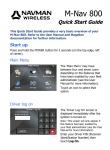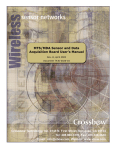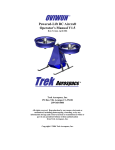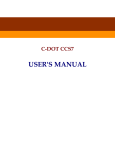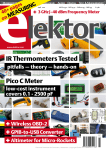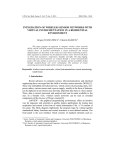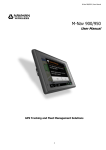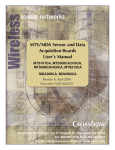Download MNAV100CA User`s Manual
Transcript
MNAV100CA User’s Manual Document 7430-0198-01 Revision A, July 2005 Crossbow Technology, Inc., 4145 N. First Street, San Jose, CA 95134 Tel: 408-965-3300, Fax: 408-324-4840 email: [email protected], website: www.xbow.com ©2005 Crossbow Technology, Inc. All rights reserved. Information in this document is subject to change without notice. Crossbow and SoftSensor are registered trademarks and MNAV is a trademark of Crossbow Technology, Inc. Other product and trade names are trademarks or registered trademarks of their respective holders. MNAV100CA User’s Manual Table of Contents 1 2 3 4 5 Introduction........................................................................................... 1 1.1 MNAV100CA Features ................................................................ 1 1.2 Package Contents.......................................................................... 2 MNAV100CA Overview...................................................................... 3 2.1 MNAV100CA Layouts................................................................. 3 2.2 MNAV100CA Board Size ............................................................ 3 2.3 Connectors .................................................................................... 5 2.4 Power Supply................................................................................ 7 2.5 GPS............................................................................................... 7 2.6 Pressure sensor.............................................................................. 7 2.7 Serial Ports.................................................................................... 7 Quick Start ............................................................................................ 8 3.1 MICRO-VIEW Software .............................................................. 8 3.1.1 MICRO-VIEW Computer Requirements.............................. 8 3.1.2 Install MICRO-VIEW........................................................... 8 3.2 Connections .................................................................................. 8 3.3 Setting up MICRO-VIEW ............................................................ 9 3.4 Take Measurements .................................................................... 11 MNAV100CA Details ........................................................................ 12 4.1 MNAV100CA Architecture........................................................ 12 4.2 MNAV100CA Coordinate System ............................................. 13 4.3 Measurement Modes................................................................... 13 4.3.1 Voltage Mode ..................................................................... 13 4.3.2 Scaled mode........................................................................ 14 4.4 Sensor Calibration....................................................................... 15 4.5 Commands .................................................................................. 15 4.5.1 Input Packets....................................................................... 16 4.5.2 Output Packets .................................................................... 16 4.5.3 Command List..................................................................... 17 4.6 Data Packet Format..................................................................... 21 MNAV100CA as a Development Platform ........................................ 27 5.1 MNAV100CA hardware development platform......................... 27 5.2 Using the AVR GCC Toolchain ................................................. 27 Doc# 7430-0198-01 Rev. A Page i MNAV100CA User’s Manual 5.3 Loading the New Application into MNAV100CA ..................... 27 6 Limitations .......................................................................................... 28 6.1 Installation .................................................................................. 28 6.2 Range Limitations....................................................................... 28 7 Appendix A. Mechanical Specifications............................................. 29 7.1 MNAV100CA Outline Drawing ................................................. 29 8 Appendix B. Sensor Calibration ......................................................... 30 8.1 Introduction................................................................................. 30 8.2 Sensor Calibration Procedure using MICRO-VIEW .................. 30 9 Appendix C. Servo control.................................................................. 32 9.1 Introduction................................................................................. 32 9.2 Debugging Servos using MICRO-VIEW.................................... 32 10 Appendix D. PPM GUI................................................................... 34 10.1 Introduction................................................................................. 34 10.2 PPM GUI in MICRO-VIEW....................................................... 34 11 Appendix E. Sensors List................................................................ 36 12 Appendix F. Warranty and Support Information ............................ 37 12.1 Customer Service ........................................................................ 37 12.2 Contact Directory........................................................................ 37 12.3 Return Procedure ........................................................................ 37 12.3.1 Authorization ...................................................................... 37 12.3.2 Identification and Protection ............................................... 38 12.3.3 Sealing the Container .......................................................... 38 12.3.4 Marking............................................................................... 38 12.3.5 Return Shipping Address .................................................... 38 12.4 Warranty ..................................................................................... 38 Page ii Doc# 7430-0198-01 Rev. A MNAV100CA User’s Manual About this Manual The following annotations have been used to provide additional information. ; NOTE Note provides additional information about the topic. ; EXAMPLE Examples are given throughout the manual to help the reader understand the terminology. 3 IMPORTANT This symbol defines items that have significant meaning to the user 0 WARNING The user should pay particular attention to this symbol. It means there is a chance that physical harm could happen to either the person or the equipment. The following paragraph heading formatting is used in this manual: 1 Heading 1 1.1 Heading 2 1.1.1 Heading 3 Normal Doc# 7430-0198-01 Rev. A Page iii MNAV100CA User’s Manual 1 Introduction The MNAV100CA is a calibrated digital sensor system with servo drivers, designed for miniature ground and air robotic vehicle navigation and control. All sensors required for complete airframe stabilization and navigation are integrated into one compact module. The MNAV100CA includes 3-axis accelerometers, 3-axis angular rate sensors, and 3-axis magnetometers; static pressure (altitude) and dynamic pressure (airspeed) sensors; and a GPS receiver module. The MNAV100CA R/C servo controller allows direct connection of R/C servos to MNAV100CA. The R/C Receiver PPM interface allows for software interpretation of R/C receiver commands (PPM) and switching between software control and R/C receiver control for human “takeover” capability. The MNAV100CA has two RS-232 serial ports. The sensor data may be requested via serial port ‘0’ as a single measurement or streamed continuously. And GPS can be directly read from serial port ‘1’. The MNAV100CA can plug into a Crossbow Stargate via the 51-pin connector to form a sophisticated open-source inertial platform. The MNAV100CA firmware and tool chain is open-source for maximum user flexibility. PC based MICRO-VIEW software is included to facilitate recalibration of the MNAV100CA sensors. 1.1 MNAV100CA Features Figure 1.1 MNAV100CA Robotics Sensor Suite • Miniature, Low Cost Robotic Vehicle Sensor Suite • Onboard R/C Servo Controller Doc# 7430-0198-01 Rev. A Page 1 MNAV100CA User’s Manual • Standard 51-Pin Connector for Optional Stargate Auto-Pilot Interface • Pre-installed with Open Source Inertial Firmware • Sensor Calibration and Servo Control via MICRO-VIEW GUI 1.2 Package Contents In addition to your MNAV100CA sensor product you should have: • Three Cables o two digital signal cables o one power cable • GPS Antenna • One CD with Manual, Open Source Code, Software and development tool chain The open source code is an application program that you can use on MNAV100CA, and it is a good starting point for you to write you own code. The boot loader software is offered for loading the firmware image file into the microcontroller via an RS-232 link. The user interface software, MICRO-VIEW will allow you to immediately view the outputs of the MNAV100CA on a PC running Microsoft® Windows™. The software also allows you to recalibrate the MNAV100CA sensors in some situations. The development tool chain is AVR GCC installation software. The MNAV100CA User’s Manual contains helpful hints on programming, installation and valuable digital interface information including command structure, data packet formats and conversion factors. Page 2 Doc# 7430-0198-01 Rev. A MNAV100CA User’s Manual 2 2.1 MNAV100CA Overview MNAV100CA Layouts LEDs MMCX Connector Pitot Hole Connector 1 Barometer Figure 2.1 MNAV100CA Board 2.2 MNAV100CA Board Size Figure 2.2 shows the outline dimensions of the MNAV100CA board. Doc# 7430-0198-01 Rev. A Page 3 MNAV100CA User’s Manual (All dimensions are in inches ) Figure 2.2 Page 4 MNAV100CA Board Dimensions Doc# 7430-0198-01 Rev. A MNAV100CA User’s Manual 2.3 Connectors Connector 1(See Figure 2.1) provides an interface to the power supply connector, the servo battery connector, two RS232 connectors, a PPM input connector, 9 servo connectors and a high speed servo connector. These are compatible with standard servo battery and servo connectors. Figure 2.3 shows the top view of Connector 1 showing the pin numbers and the dimensions. Table 2.1 lists the pin assignments for this connector. Figure 2.3 Table 2.1 Pin 1 – 15,31 16,32 17,20-30 18 33 19 34 35 36 37 38 39 40 41 42 43 Doc# 7430-0198-01 Rev. A Connector 1 Pinout Connector 1 Pin Assignments Function Ground Input Power Servo Power RS-232 Receive Port 0 RS-232 Transmit Port 0 RS-232 Receive Port 1 RS-232 Transmit Port 1 PPM Input High Speed Servo PWM Servo 8 PWM Servo 7 PWM Servo 6 PWM Servo 5 PWM Servo 4 PWM Servo 3 PWM Servo 2 PWM Page 5 MNAV100CA User’s Manual 44 45 Servo 1 PWM Servo 0 PWM The 51-pin male connector (See Figure 2.2) on the bottom side of the MNAV100CA board provides the interface to connect to the Stargate. Table 2.2 shows the pin assignments for this connector. Table 2.2 51-Pin Connector Pin Assignments Pin 1 2 – 15 16 17 18 19 20 21 – 26 27 28 29 ~ 35 36 37 38 39 40 – 47 48 49 50 51 Function Ground Not Connected Serial Program MOSI Serial Program MISO SPI Serial Clock GPS UART1 RXD GPS UART1 TXD Not Connected MCU UART0 RXD MCU UART0 TXD Not Connected JTAG Port TDI JTAG Port TDO JTAG Port TMS JTAG Port TCK Not Connected Reset Not Connected Input Power Ground The MMCX connector (See Figure 2.1) provides connectivity to the GPS antenna. Page 6 Doc# 7430-0198-01 Rev. A MNAV100CA User’s Manual 2.4 Power Supply The MNAV100CA can be powered by using a 4.5V to 16V DC power supply through a 3-pin connector, or powered by 3.3V through the51-pin connector. Pin 1, 16 and 31 in Figure 2.3 form a 3-pin connector for the power supply. The input voltage can range from 4.5V to 16V. The typical power consumption is [email protected], and less than 60mA@16V. Pin 2 and 17 form a connector for the servo battery. Pin 2 is Ground and Pin 17 is the Servo Power. For some applications, only one battery is used to drive both the MNAV100CA and the servos and the MNAV100CA hardware allows this. To enable this, power the system from Pin 1, 16 and 31, and use a jumper connector to short Pin 17 and 32. Care should be taken to make sure that: 1. The supply voltage is the standard servo voltage; 2. The power supply has the capability of driving the MNAV100CA and all the servos together. (Generally, the peak current of each servo can be as high as 1 A.) If the MNAV100CA is powered through the 51-pin connector, it is recommended not to connect a power supply to the 3-pin power supply connector. For example, plug MNAV100CA onto the Stargate board and power up the Stargate. The Stargate and MNAV100CA will work together! 2.5 GPS A GPS receiver is integrated into the MNAV100CA A GPS antenna with the MMCX male connector can be directly plugged into the MNAV100CA MMCX connector (See Figure 2.1). This GPS receiver has two serial ports: GPS USART1 (9600 Baud, 8 bits, no parity bit, 1 stop bit) and GPS USART2 (57600 Baud, 8 bits, no parity bit, 1 stop bit). The GPS USART2 is connected to MCU USART1 of the onboard AVR microcontroller. 2.6 Pressure sensor The relative pressure sensor has an axial port shown as Pitot Hole in Figure 2.1. The diameter of the axial port is 0.12 inch, and the length is 0.25 inch. 2.7 Serial Ports The MNAV100CA has two serial ports: Serial Port 0 (Pin 3, 18 and 33) and Serial Port 1 (Pin 3, 19 and 34). USART0 of the onboard ATmega128L microcontroller is converted to standard RS-232 and forms Serial Port 0 of the MNAV100CA. The onboard GPS Receiver’s Serial Port 1 is converted to standard RS-232 and made available as Serial Port 1 of the MNAV100CA. Doc# 7430-0198-01 Rev. A Page 7 MNAV100CA User’s Manual 3 Quick Start 3.1 MICRO-VIEW Software Crossbow includes MICRO-VIEW software to allow use of the MNAV100CA right out of the box and makes the evaluation straightforward. Install the MICRO-VIEW software, connect the MNAV100CA to your serial port, apply power to your unit and start taking measurements. ; NOTE The MICRO-VIEW is a good GUI for a PC to talk to the MNAV100CA factory installed firmware. Because the MNAV100CA firmware and tool chain are open-source, Crossbow cannot guarantee that MICRO-VIEW would still work if the onboard firmware is changed. 3.1.1 MICRO-VIEW Computer Requirements The following are minimum capabilities that your computer should have to run MICRO-VIEW successfully: • CPU: Pentium-class • RAM Memory: 64MB minimum • Hard Drive Free Memory: 80MB • Operating System: Windows 2000, XP 3.1.2 Install MICRO-VIEW To install MICRO-VIEW in your computer: 1. Insert the CD in the CD-ROM drive. 2. Run <CDROM>:\ MICRO-VIEW1.0\setup.exe, follow the wizard to install MICRO-VIEW. 3.2 Connections The MNAV100CA is shipped with 3 cables: two digital signal cables and one power cable to connect the MNAV100CA to a PC Serial port and power supply. Follow the instructions below: 1. Connect the 3-pin end of the power cable to the power pins (1, 16 and 31) of Connector 1 of the MNAV100CA. 2. Connect the other end of the power cable to the batteries or other DC power supply. Page 8 Doc# 7430-0198-01 Rev. A MNAV100CA User’s Manual 0 WARNING Do not reverse the power leads! Applying the wrong power to the MNAV100CA can damage the unit. There is no reverse voltage protection and Crossbow Technology is not responsible for resulting damage to the unit. Table 3.1 Power Cable Connections Wire Color Red Brown 3. 4. Function Power Input (4.5-16V) Power Ground Connect the 3-pin end of the digital signal cable to the RS232 pins (3, 18 and 33) of Connector 1 of the MNAV100CA. Connect the 9-pin end of the digital signal cable to the serial port of your computer. Table 3.2 Digital Signal Cable Connections Wire Color Function Grey / Yellow RS-232 Transmit Data White / Green RS-232 Receive Data Black / Blue RS-232 Signal Ground Let the MNAV100CA warm up for 10 minutes when powered on for temperature stability before attempting a calibration. 3.3 Setting up MICRO-VIEW With the MNAV100CA connected to your PC serial port and powered, open the MICRO-VIEW software. 1. MICRO-VIEW should automatically detect the MNAV100CA, display the serial number and firmware version. Set the MNAV100CA to default status: voltage output data-packet, 100Hz update rate and 38400 baud. 2. If the text in connection frame is “Disconnected”, that shows that MICRO-VIEW cannot connect. Verify that you have the correct COM port selected. This can be changed from the “Serial Port” dropdown menu. If it still does not work, check the connections between the MNAV100CA and the computer; check the power; check the serial COM port assignment on your computer. Doc# 7430-0198-01 Rev. A Page 9 MNAV100CA User’s Manual 3. Set the update rate and serial communication baud rate as you need, select output packet type from the “Output” dropdown menu. In Voltage packet, only the voltage output of the sensors is displayed; in Scaled packet, the scaled sensor output and the static attitude & heading angles with a cubic demo are displayed. Figure 3.1 the main window of MICRO-VIEW 4. 5. 6. 7. Page 10 Select the type of sensor data you want to display in Graphs from the “Sensor” menu. You can zoom into the waveform by “Shift + Click Mouse Left/Right Button” and pan it by “Ctrl + Press Mouse Left Button”. By selecting the submenu “Tile” or “Cascade” of “Windows”, you can tile or cascade the sensor Graph windows. You can log data to a data file from the “Logging” menu. You can calibrate the MNAV100CA sensors in voltage mode. Select “Start Cali” from the “Calibration” menu and the calibration interface window will appear. See Appendix B for detailed calibration instructions. You can debug the servos by selecting “Servo” from the “Servo/PPM” menu. See Appendix C for detailed servo debug. Doc# 7430-0198-01 Rev. A MNAV100CA User’s Manual 8. 9. PPM GUI is enabled when the output rate is less than 100 Hz in scaled mode. Select “PPM” from the “Servo/PPM” menu and the PPM window will appear. See Appendix D for detailed instructions. You can replay from data file by selecting “Load and Replay” from the “File” menu and select submenu “Halt” or “Stop” if you want to halt or stop the replay. Please note that only the data file logged by MICRO-VIEW can be replayed. 3.4 Take Measurements Once you have configured MICRO-VIEW to work with your MNAV100CA, pick the kind of measurement you wish to see. The Graphs for rates, acceleration, magnetic flux or pressure can be displayed. Now you’re ready to use the MNAV100CA! Doc# 7430-0198-01 Rev. A Page 11 MNAV100CA User’s Manual 4 MNAV100CA Details 4.1 MNAV100CA Architecture The MNAV100CA is a nine-axis measurement system that outputs acceleration, angular rates and magnetic orientation. The MNAV100CA consists of the following subsystems: 1) Inertial Sensor Array: This is an assembly of three accelerometers, three gyros (rate sensors) with temperature sensors. 2) Three axis magneto-resistive magnetometers that can be used to compute heading. 3) A GPS receiver for position and velocity measurement. 4) A static pressure sensor and a dynamic pressure sensor that can be used to compute the altitude and airspeed. 5) Servo Driving Circuit: The integrated circuit that can support up to 9 servos. 6) The R/C Receiver PPM interface that can be used to read the PPM signal from the R/C receiver. 7) Data processing module, which receives the signals from all the sensors, GPS and PPM interface, and transmits digital data via the serial link, and outputs standard servo signals. See the Appendix E for the sensor list. These blocks are shown in the system block diagram below in Figure 4.1. Figure 4.1 MNAV100CA System Architecture The MNAV100CA analog sensor signals are sampled and converted to digital data at 100Hz. The rate gyros and accelerometers data is filtered by five pole Bessel filters and all the sensors are sampled by 16-bit A/D converters. The firmware inside the onboard processor produces calibrated Page 12 Doc# 7430-0198-01 Rev. A MNAV100CA User’s Manual angular rate measurements, calibrated acceleration measurements, and calibrated magnetometer measurements. 4.2 MNAV100CA Coordinate System The MNAV100CA coordinate system is shown in Figure 4.2. With the port of the relative pressure sensor facing the front and the mounting plate down, the axes are defined as: X-axis – along the top pointing to the side of the relative pressure sensor Y-axis – from the side of LEDs to the side of connectors Z-axis – from the top to the bottom Figure 4.2 MNAV100CA Coordinate System The axes form an orthogonal SAE right-handed coordinate system. The angular rate sensors are aligned with these same axes. The rate sensors measure angular rotation rate around a given axis. The rate measurements are labeled by the appropriate axis. The direction of a positive rotation is defined by the right-hand rule. With the thumb of your right hand pointing along the axis in a positive direction, your fingers curl around in the positive rotation direction. For example, if the MNAV100CA is sitting on a level surface and you rotate it clockwise on that surface, this will be a positive rotation around the z-axis. The x- and y-axis rate sensors would measure zero angular rates, and the z-axis sensor would measure a positive angular rate. 4.3 Measurement Modes The MNAV100CA can be set to operate in one of two modes: Voltage mode or Scaled mode. The measurement mode selects the information that is sent in the data packet over the RS-232 interface. See the “Data Packet Format” section for the actual structure of the data packet in each mode. The default system operation is Voltage mode. 4.3.1 Voltage Mode In voltage mode, the analog sensors are sampled and converted to digital data with 0.1 mV resolution. The digital data represents the direct output from the sensors. The data is 16-bit for each sensor and is sent as 2 bytes in the data packet over the serial interface. The data of the accelerometers, Doc# 7430-0198-01 Rev. A Page 13 MNAV100CA User’s Manual absolute pressure sensor and pitot pressure sensor are sent as unsigned integers where as the data of the angular rates, temperatures and magnetometers are sent as signed integers. The voltage data is scaled as: for angular rate and temperature: voltage = 2.5V+data*(5 V)/216 ; for other sensor: voltage = data*(5 V)/216 where voltage is the voltage measured at the sensor. See the “Data Packet Format” section for a complete description of the voltage mode outputs. 4.3.2 Scaled mode In scaled mode, the analog sensors are sampled and GPS data is extracted, then converted to digital data and scaled to engineering units. The digital data represents the actual value of the quantities measured. The sensor data is sent as signed 16-bit integers; GPS data for velocity, altitude, longitude and latitude is sent as signed 32-bit integers and the data for ITOW (low 2byte) is sent as 16-bit unsigned integer. See the “Data Packet Format” section for a complete description of the scaled mode outputs. To convert the acceleration data into G’s, use the following conversion: accel = data*(GR)/215 where accel is the actual measured acceleration in G’s, data is the digital data sent by the MNAV100CA, and GR is the G Range: 2 G (1 G = 9.80 m s-2). To convert the angular rate data into degrees per second, use the following conversion: rate = data*(RR)/215 where rate is the actual measured angular rate in °/sec, data is the digital data sent by the MNAV100CA, and RR is the Angular rate Range: 200 °/sec. To convert the magnetic data into Gauss, use the following conversion: magn = data*(MR)/215 where magn is the actual measured magnetic in Gauss, data is the digital data sent by the MNAV100CA, and MR is the Magnetic Range: 2 Gauss. To convert the temperature data into 0C, use the following conversion: temp = data*(TR)/215 where temp is the actual measured temperature in 0C, data is the digital data sent by the MNAV100CA, and TR is the Temperature Range: 200 0C. Page 14 Doc# 7430-0198-01 Rev. A MNAV100CA User’s Manual To convert the absolute pressure data into altitude and velocity, use the following conversion: press = data*(PR)/215 where press is the altitude in meters and velocity in m/s, data is the digital data sent by the MNAV100CA, and PR is the pressure Range: 10000m for absolute pressure and 80m/s for pitot pressure. The GPS data is directly scaled and represents velocity in cm/s, altitude in millimeters, longitude & latitude in 10e-7 degrees and ITOW in milliseconds. 4.4 Sensor Calibration A calibration procedure performed at the factory will provide initial parameters for sensors. The user can also re-calibrate sensors using the MICRO-VIEW software. The firmware will then apply these parameters to each of the sensors to provide a scaled output. • Rate sensors are calibrated for bias and scale factor. • Accelerometers are calibrated for bias and scale factor. • Magnetometers are calibrated for bias and scale factor. • Pressure sensors are calibrated for bias, and default scale factor is stored in EEPROM. See Appendix B for detailed calibration instructions. 4.5 Commands The MNAV100CA has a simple command packet structure. You send a command to the MNAV100CA over the RS-232 interface and the MNAV100CA will execute the command. All communications to and from the unit are packets that start with a two-byte header 0x5555. This is the ASCII string “UU”. All communications packets except for the ping command and response end with a two-byte checksum. The checksum is calculated in the following manner: 1. Byte-wise sum packet contents excluding the header and checksum itself. 2. The least significant 16-bits are the checksum. MICRO-VIEW is the tool to use when troubleshooting your device. MICRO-VIEW formulates the proper command structures and sends them over the RS-232 interface. You can use MICRO-VIEW to verify that the MNAV100CA is functioning correctly. MICRO-VIEW does not use any commands that are not listed here. Doc# 7430-0198-01 Rev. A Page 15 MNAV100CA User’s Manual 3 IMPORTANT The commands and MICRO-VIEW support the factory firmware. If the user makes some changes in the open source code and loads the new image file into the atmega128L, neither the commands nor MICRO-VIEW can be guaranteed to work. 4.5.1 Input Packets All communications sent to the unit except for the ping command are input packets with the following format: UU <2-byte command> <variable length data> <2-byte checksum> This generalized input structure allows input commands to carry data for advanced user interaction. All input packets can be no longer than 128 bytes. All two-byte input commands consist of a pair of ASCII characters. As a semantic aid, consider the following single character acronyms: P = packet F = fields (these are settings or data contained in the unit) R = read (pertains to default non-volatile fields) G = get (pertains to current fields or settings) W = write (pertains to default non-volatile fields) S = set (pertains to current fields or settings) G and S refer to current fields. Modifying current fields with S takes effect immediately and are lost on a power cycle. R and W refer to default power up fields. These fields are stored in non-volatile memory and determine the unit’s behavior on power up. Modifying default fields takes effect on the next power up and thereafter. There are 5 user input commands: PK, GP, WF, SF and SS. ; NOTE The MNAV100CA commands are case sensitive! 4.5.2 Output Packets All communications received from the unit except for the ping response are output packets with the following format: UU <1-byte packet type> <variable length data> <2-byte checksum> All packet types will be single printable ASCII characters. All output packets can be no longer than 128 bytes. Page 16 Doc# 7430-0198-01 Rev. A MNAV100CA User’s Manual There are 5 output packet types: P, D, S, A and N. The P is response type packet, which is sent in response to a Ping request. The remaining packets are available using the get packet command (polling) or can be configured for continuous (fixed rate) output. 4.5.3 Command List Command Ping Input Packet UU PK Response Packet UU P Description Pings MNAV100CA to verify communications. The ping command does not have data or a checksum to facilitate human interaction from a keyboard. Sending the ping command will cause the unit to send a ping response. All bytes sent and received during the ping command and responses are ASCII printable characters. Command Query Serial Number and Firmware Version Input Packet UU GP D Checksum Response Packet UU D Serial Number Version String Checksum Description This queries the MNAV100CA for its serial number and firmware version. The serial number contains 4-bytes and should be interpreted as two words, lowest-order-word first, but with highest-order-byte of each word sent first. For example, if the expected serial number is 4003012 or hex 0x003D14C4, then the byte sequence in the serial stream is: 0x14C4003D. The firmware version is an ASCII string that describes the MNAV100CA firmware version. Command Write/Set Fields Input Packet Response UU WF or SF <1-byte num of fields> <list of fields> <field data> Checksum None Doc# 7430-0198-01 Rev. A Page 17 MNAV100CA User’s Manual Description This command allows the user to write default power-up configuration fields to the EEPROM (WF) or set the unit’s current configuration (SF) fields, which will be lost on power down. Writing the default configuration will not take affect until the unit is power cycled. Num of fields is the number of words to be written/set. The list of fields are the field IDs that will be written with the field data, respectively. The unit will not write to calibration or algorithm fields. The unit will not respond to this command. Command Change Baud Rate Input Packet UU WF 0x01 0x0002 Checksum Value Response None Description This changes the default power-up baud rate of the MNAV100CA. Upon sending the command, power cycle the unit for the change to take effect. The available 2-byte Value options and their corresponding baud rates are listed below: Value 0 1 2 3 Hex Value 0x0000 0x0001 0x0002 0x0003 Baud Rate 9600 19200 38400 57600 For example, to change the default baud rate to 9600, send 0x55555746010002000000A0 Command Input Packet Change Packet Type UU WF or SF 0x01 0x0003 Value Checksum Response None Description This command allows the user to change the measurement mode. If you want to change the packet type only temporarily, use SF instead of WF in the command packet above. The available 2-byte Value options and their corresponding power-up modes are listed below: Value Page 18 Hex Value Measurement Mode Doc# 7430-0198-01 Rev. A MNAV100CA User’s Manual ‘V’ 0x0056 Voltage Packet ‘S’ 0x0053 Scaled Packet For example, to temporarily change the packet type to Scaled, send 0x55555346010003005300F0 Command Input Packet Change Packet Output Rate UU WF or SF 0x01 0x0001 Value Checksum Response None Description This command allows the user to change the packet output rate. If you want to change the packet rate only temporarily, use SF instead of WF in the command packet above. The available 2-byte Value options and their corresponding power-up modes are listed below: Value Hex Value Output Rate 0 0x0000 Quiet 1 0x0001 100 Hz* 2 0x0002 50 Hz* 4 0x0004 25 Hz 5 0x0005 20 Hz 10 0x000A 10 Hz 50 0x0032 2 Hz When the output rate is set to Quiet, the unit goes into Polled mode. For example, to set the unit temporarily into Polled mode, send 0x555553460100010000009B * The 100Hz and 50Hz update rates can be achieved only at baud rates 38400 and higher. Command Input Packet Set Servos output UU SS <1-byte num of servos> <1-byte No. of the first servo> <2-byte output value of the first servo> <1-byte No. of the second servo> <2-byte output value of the second servo> … <1-byte No. of the last servo> <2-byte output value of the last servo> Checksum Doc# 7430-0198-01 Rev. A Page 19 MNAV100CA User’s Manual Response None Description This command allows the user to set the position of the servos, the number of servos set in this command ranges from 1 to 9, which is specified as 1 byte num of servos in the input packet. The servo channels and their corresponding byte value is listed below: Servo Channel ID Byte Value 0 0x07 1 0x03 2 0x06 3 0x02 4 0x00 5 0x01 6 0x05 7 0x04 8 0x08 For example, to set the servo 0 to maximum pulse width, send 0x55555353 01 07 FFFF 02AC; to set TWO servos servo 0 at minimum pulse width and servo 1 at the middle point, send 0x55555353 02 07 0000 03 8000 0132. Command Input Packet Set Reverse Bits of PPM Signals UU SP <1-byte Reverse Bits> Checksum Response None Description This command allows the user to set the motion direction of the servos. Bit 0~7 of 1-byte Reverse Bits in this command is the motion direction flags of the servos from channel 0 to 7 respectively. For example, if Bit 0 is reset, the pulse width of channel 0 in PPM signal will be directly output to channel 0 of servo interface. If Bit 0 is set, the pulse width of channel 0 in PPM signal will be reversed and then output to channel 0 of servo interface. Page 20 Doc# 7430-0198-01 Rev. A MNAV100CA User’s Manual 4.6 Data Packet Format In general, the digital sensor data representing each measurement is sent as a 16-bit number (two bytes). Between voltage and scaled mode, the data packet format is different as below: 1) In voltage mode: only the voltage outputs of sensors are provided in a 33 byte packet. See Table 4.1-1 as reference. 2) In scaled mode: the output data packet consists of the scaled outputs of sensors (28 bytes), the GPS data (35 bytes, Table 4.1-6) if available, and the PPM data (18 bytes, Table 4.1-7) if output rate is less than 100Hz. The content and length of the data packet under different conditions is described in the following table. Conditions Output data packet Output rate GPS available Content Length (Bytes) Reference 100Hz No Scaled 33 Table 4.1-2 Yes Scaled, GPS1 38 Table 4.1-3 No Scaled, PPM 51 Table 4.1-4 Yes Scaled, GPS2, PPM 86 Table 4.1-5 <=50Hz In the table, “Scaled” represents “Scaled output of sensors”; “GPS1” is a five byte packet divided from the whole GPS packet, see Table 4.2; “GPS2” is the whole GPS packet, see Table 4.1-6. The above table is valid for baud rates 38,400 or higher. When the update rate is 100Hz, the GPS data is divided into 7 packets (each packet contains 5 bytes), See Table 4.1-3 and 4.2 as reference. Each data packet will begin with a two-byte header (hex 55 55) and end with a two-byte checksum. The checksum is calculated in the following manner: 1. Byte-wise sum packet contents excluding the header and checksum itself. 2. The least significant 16-bits is the checksum. The packet also contains a byte representing the MNAV100CA working mode. The detailed description of the data packet is shown in table 4.1. Doc# 7430-0198-01 Rev. A Page 21 MNAV100CA User’s Manual Table 4.1 MNAV100CA Data Packet Format Bytes 1,2 3 4.1-1 Voltage Mode Packet Description Range Units Header (0x5555) ‘V’ 4,5 X-Axis Acceleration [0, 5] V 6,7 Y-Axis Acceleration [0, 5] V 8,9 Z-Axis Acceleration [0, 5] V 10,11 X-Axis Angular Rate [0, 5] V 12,13 Y-Axis Angular Rate [0, 5] V 14,15 Z-Axis Angular Rate [0, 5] V 16,17 X-Axis Magnetic Field [-1, 1] V 18,19 Y-Axis Magnetic Field [-1, 1] V 20,21 Z-Axis Magnetic Field [-1, 1] V 22,23 X-Axis Temperature [0, 5] V 24,25 Y-Axis Temperature [0, 5] V 26,27 Z-Axis Temperature [0, 5] V 28,29 Abs Pressure [0, 5] V 30,31 Pitot Pressure [0, 5] V 32,33 Checksum 4.1-2 Scaled Mode Packet (Output Rate =100Hz, Without GPS Data) Bytes Description Range Units 1,2 3 Page 22 Header (0x5555) ‘S’ 4,5 X-Axis Acceleration [-2, 2] G 6,7 Y-Axis Acceleration [-2, 2] G 8,9 Z-Axis Acceleration [-2, 2] G 10,11 X-Axis Angular Rate [-200, 200] Deg/sec 12,13 Y-Axis Angular Rate [-200, 200] Deg/sec 14,15 Z-Axis Angular Rate [-200, 200] Deg/sec 16,17 X-Axis Magnetic Field [-1, 1] Gauss 18,19 Y-Axis Magnetic Field [-1, 1] Gauss 20,21 Z-Axis Magnetic Field [-1, 1] Gauss 22,23 X-Axis Temperature [-200, 200] 0 C 24,25 Y-Axis Temperature [-200, 200] 0 C Doc# 7430-0198-01 Rev. A MNAV100CA User’s Manual 26,27 Z-Axis Temperature [-200, 200] 0 C 28,29 Abs Pressure [-100,10000] m 30,31 Pitot Pressure [0, 80] m/s 32,33 Checksum 4.1-3 Scaled Mode Packet (With GPS Data, output rate = 100Hz) Bytes Description Range Units 1,2 3 Header (0x5555) ‘N’ 4,5 X-Axis Acceleration [-2, 2] 6,7 Y-Axis Acceleration [-2, 2] G G 8,9 Z-Axis Acceleration [-2, 2] G 10,11 X-Axis Angular Rate [-200, 200] Deg/sec 12,13 Y-Axis Angular Rate [-200, 200] Deg/sec 14,15 Z-Axis Angular Rate [-200, 200] Deg/sec 16,17 X-Axis Magnetic Field [-1, 1] Gauss 18,19 Y-Axis Magnetic Field [-1, 1] Gauss 20,21 Z-Axis Magnetic Field [-1, 1] Gauss 22,23 X-Axis Temperature [-200, 200] 0 C 24,25 Y-Axis Temperature [-200, 200] 0 C 26,27 Z-Axis Temperature [-200, 200] 0 C 28,29 Abs Pressure [-100,10000] m 30,31 Pitot Pressure [0, 80] m/s 32~36 Divided five byte of GPS package 37,38 Checksum 4.1-4 Scaled Mode Packet (Output rate < 100Hz, with PPM, without GPS Data) Bytes Description Range Units 1,2 3 Header (0x5555) ‘N’ 4,5 X-Axis Acceleration 6,7 Y-Axis Acceleration [-2, 2] G 8,9 Z-Axis Acceleration [-2, 2] G 10,11 X-Axis Angular Rate [-200, 200] Deg/sec 12,13 Y-Axis Angular Rate [-200, 200] Deg/sec 14,15 Z-Axis Angular Rate [-200, 200] Deg/sec Doc# 7430-0198-01 Rev. A [-2, 2] G Page 23 MNAV100CA User’s Manual 16,17 X-Axis Magnetic Field [-1, 1] Gauss 18,19 Y-Axis Magnetic Field [-1, 1] Gauss 20,21 Z-Axis Magnetic Field [-1, 1] Gauss 22,23 X-Axis Temperature [-200, 200] 0 C 24,25 Y-Axis Temperature [-200, 200] 0 C 26,27 Z-Axis Temperature [-200, 200] 0 C 28,29 Abs Pressure [-100,10000] m 30,31 Pitot Pressure [0, 80] m/s 32~49 PPM data packet 50,51 Checksum 4.1-5 Scaled Mode Packet (Output rate < 100Hz, with PPM and GPS Data) Bytes Description Range Units 1,2 3 Header (0x5555) ‘N’ 4,5 X-Axis Acceleration 6,7 Y-Axis Acceleration [-2, 2] G 8,9 Z-Axis Acceleration [-2, 2] G 10,11 X-Axis Angular Rate [-200, 200] Deg/sec 12,13 Y-Axis Angular Rate [-200, 200] Deg/sec 14,15 Z-Axis Angular Rate [-200, 200] Deg/sec 16,17 X-Axis Magnetic Field [-1, 1] Gauss 18,19 Y-Axis Magnetic Field [-1, 1] Gauss 20,21 Z-Axis Magnetic Field [-1, 1] Gauss 22,23 X-Axis Temperature [-200, 200] 0 C 24,25 Y-Axis Temperature [-200, 200] 0 C 26,27 Z-Axis Temperature [-200, 200] 0 C 28,29 Abs Pressure [-100,10000] m [0, 80] m/s 30,31 Pitot Pressure 32~66 GPS data packet 67~84 PPM data packet 85,86 Checksum [-2, 2] G ; NOTE The 200 deg/sec is digital scaling range of the angular rate sensors. The actual measurement range of angular rate sensors is ± 150 deg/sec. Page 24 Doc# 7430-0198-01 Rev. A MNAV100CA User’s Manual 4.1-6 GPS Data Packet Description Units Bytes 1,2 Notes Header (0x5555) 3 ‘G’ 4,5,6,7 North Velocity Cm/s LSB first 8,9,10,11 East Velocity Cm/s LSB first 12,13,14,15 Earth Velocity Cm/s LSB first 16,17,18,19 Longitude 10e-7 Deg LSB first 20,21,22,23 Latitude 10e-7 Deg LSB first 24,25,26,27 Altitude mm LSB first ITOW ms LSB first 28,29 30,31,32,33 Reserved 34,35 Checksum =0 4.1-7 PPM Data Packet Bytes Description Notes 1 ‘F’ (0x46) 2 Status Byte (1) 3,4 Channel 0 MSB first 5,6 Channel 1 7,8 Channel 2 9,10 Channel 3 11,12 Channel 4 13,14 Channel 5 15,16 Channel 6 17,18 Channel 7 Header ; NOTE (1) Bits 0~7 of the Status Byte are the motion direction flags of the servos from channel 0 to 7 respectively. For example, if Bit 0 is reset, the pulse width of channel 0 in PPM signal will be directly output to channel 0 of servo interface. If Bit 0 is set, the pulse width of channel 0 in PPM signal will be reversed and then output to channel 0 of servo interface. When the output rate is 100Hz, the GPS data is divided into 7 packets following the sensor data as shown in Table 4.2. Doc# 7430-0198-01 Rev. A Page 25 MNAV100CA User’s Manual Suppose the time is “0” when one complete GPS data-packet is valid, and the GPS update rate is F Hz (F=1 ~ 4). Define one complete GPS data transport cycle as 1/F seconds {0 ~ (1/F0.01)}. In each cycle, the GPS data is transported from time “0” and after these 7 packets are completed, the data packet format changes to Scaled Mode Data packet without GPS data (see table 4.1-2). The data format is shown as below. Table 4.2 GPS Data Transport Cycle, MNAV100CA output rate = 100Hz, GPS output rate=F Hz Time( s) Bytes 1,2 3 Packet Length 4~31 32~36 (see Table 4.1-3) 37,38 0 0x5555 ‘N’ Sensors data GPS Packet Bytes: 1~5 Checksum 0.01 0x5555 ‘N’ Sensors data GPS Packet Bytes: 6~10 Checksum 0.02 0x5555 ‘N’ Sensors data GPS Packet Bytes: 11~15 Checksum 0.03 0x5555 ‘N’ Sensors data GPS Packet Bytes: 16~20 Checksum 0.04 0x5555 ‘N’ Sensors data GPS Packet Bytes: 21~25 Checksum 0.05 0x5555 ‘N’ Sensors data GPS Packet Bytes: 26~30 Checksum 0.06 0x5555 ‘N’ Sensors data GPS Packet Bytes: 31~35 Checksum 0.07 Scaled Mode Packet without GPS Data, see Table 4.1-2 … … … ... ... … 1 / F0.01 Scaled Mode Packet without GPS Data, see Table 4.1-2 Page 26 38 Bytes 33 Bytes Doc# 7430-0198-01 Rev. A MNAV100CA User’s Manual 5 MNAV100CA as a Development Platform 5.1 MNAV100CA hardware development platform The MNAV100CA utilizes an ATmega128L microcontroller to manage two 8-channel 16-bit A/D converters, GPS receiver, 9 servo interfaces, the PPM input interface and sensor calibration in the internal EEPROM. Refer to Atmel Website at http://www.atmel.com for the datasheet of the ATmega128L. 5.2 Using the AVR GCC Toolchain The firmware of the MNAV100CA is compiled under AVR GCC version: 20040404. The AVR-GCC is a freeware C compiler (and assembler) that is made available through the GNU project. AVR GCC version: 20040404 installation software is located at <CD-ROM>:\Software Tools\WinAVR20040404-bin-install.exe. These tools may also be obtained directly from http://www.avrfreaks.net/ or http://sourceforge.net/projects/winavr/. You can refer to these sites for updates and changes to the tools. 5.3 Loading the New Application into MNAV100CA The boot loader in the Boot Flash Section of the ATmega128L allows the CPU to program the application flash of the ATmega128L via MNAV100CA Serial Port 0. The Boot Loader Tool for the PC is shipped with the CD-ROM, located at <CD-ROM>:\Software Tools\MNAV PC Loader.exe. Please read the instructions in the GUI of the software before using it. Doc# 7430-0198-01 Rev. A Page 27 MNAV100CA User’s Manual 6 Limitations 6.1 Installation The MNAV100CA should be mounted as close to the center of gravity (CG) of your system as possible. 6.2 Range Limitations The internal sensors in the MNAV100CA are limited to maneuvers of less than 150 deg/sec and less than 2 Gs in acceleration. Page 28 Doc# 7430-0198-01 Rev. A MNAV100CA User’s Manual 7 7.1 Appendix A. Mechanical Specifications MNAV100CA Outline Drawing (All dimensions are in inches) Doc# 7430-0198-01 Rev. A Page 29 MNAV100CA User’s Manual 8 Appendix B. Sensor Calibration 8.1 Introduction The sensors of the MNAV100CA output voltages, which can be converted to the scaled values to represent physical units. The zero bias and scale factor are necessary for this conversion. So it is necessary to perform a calibration to get the accurate zero-bias and scale factor values for the sensors. The parameters mentioned above are provided from the factory calibration, users can also re-calibrate the sensors by using MICRO-VIEW software. 8.2 Sensor Calibration Procedure using MICRO-VIEW When you use the MICRO-VIEW software for calibration, the software gathers data from the MNAV100CA via RS232, and then processes this data to compute the parameters. The calibration procedure involves several steps: 1) Place the MNAV100CA with the x-axis pointing up on a level surface, connect RS232 cable to PC, power the MNAV100CA and then wait for 10 minutes. 2) Start “MNAV-VIEW”, select COM Port, Update Rate and set the MNAV100CA in “Volt Mode”. Click on the “Calibration” button to enter the calibration interface. 3) Click on “Keep Still”, keep the unit still and wait for 10 seconds. Then click on “Finish this Step”. Step 4 ~ 7: Calibrate Scale Factors of Gyroscopes 4) In the gyroscope section, select the angle you want to rotate through when you calibrate the scale factors of the gyros. 5) Click on “X-Rotate”, rotate the MNAV100CA through the angle specified in step 4 around the positive x-axis direction, and then click on “Finish This Step”. 6) Click on “Y-Rotate”, rotate the MNAV100CA through the angle specified in step 4 around the positive y-axis direction, and then click on “Finish This Step”. 7) Click on “Z-Rotate”, rotate the MNAV100CA through the angle specified in step 4 around the positive z-axis direction, and then click on “Finish This Step”. Step 8 ~ 13: Calibrate Bias and Scale Factors of Accelerometers 8) In the accelerometers section, place the MNAV100CA with the xaxis pointing up on the level surface, click on “X-Up”, keep the unit still for 10 seconds, and then click on “Finish this Step”. Page 30 Doc# 7430-0198-01 Rev. A MNAV100CA User’s Manual 9) Place the MNAV100CA with the x-axis pointing down on the level surface, click on “X-Down”, keep the MNAV100CA still for 10 seconds, and then click on “Finish This Step”. 10) Place the MNAV100CA with the y-axis pointing up on the level surface, click on “Y-Up”, keep the MNAV100CA still for 10 seconds, and then click on “Finish This Step”. 11) Place the MNAV100CA with the y-axis pointing down on the level surface, click on “Y-Down”, keep the MNAV100CA still for 10 seconds, and then click on “Finish This Step”. 12) Place the MNAV100CA with the z-axis pointing up on the level surface, click on “Z-Up”, keep the MNAV100CA still for 10 seconds, and then click on “Finish This Step”. 13) Place the MNAV100CA with the z-axis pointing down on the level surface, click on “Z-Down”, keep the MNAV100CA still for 10 seconds, and then click on “Finish This Step”. 14) To calibrate magnetometers for relative field estimate, in magnetometers section, repeat steps 8~13. Step 15~17: Calibrate the zero bias of the pressure sensors: 15) In the pressure section, click on “Ground Level Zero”, keep the MNAV100CA still for 10 seconds, and then click on “Finish This Step”. 16) Keep the port of the pressure sensor open to the static air, click on “Static Zero”, keep the MNAV100CA still for 10 seconds, and then click on “Finish This Step”. 17) The default scale factors of absolute pressure and pitot pressure have been shown in relevant sections, and stored in EEPROM. 18) Click on “Check Cali Result”, if “Pass” is displayed, the calibration result is valid; if “Failure” with some help message is shown, please follow the instructions in the help message. 19) Click the little button “R” next to the text frame if you want to read the parameter of a certain sensor; click on “Read all Parameters from EEPROM” if you want to read the parameters of all sensors from EEPROM. 20) The Zero Bias and Scale Factor of gyros, accelerometers and magnetometers are shown in the text frames. Click the little button “W” next to the text frame if you want to write a parameter of a certain sensor; click the button “Write all Parameters to EEPROM” if you want to write the parameters of all sensors to EEPROM. 21) Cycle the power to the MNAV100CA, and set MICRO-VIEW in ‘Scaled Mode’. The graphs of the sensor outputs are shown. You can verify if the calibration you performed is working well. Doc# 7430-0198-01 Rev. A Page 31 MNAV100CA User’s Manual 9 Appendix C. Servo control 9.1 Introduction The MNAV100CA provides the ability to control servos, which can help users to make a complete control system. The MNAV100CA can support a maximum of 9 servo channels. You can drive the servos by sending the command “Set Servo Output” described in 4.5.3, and you also can debug the servos by using the MICRO-VIEW software. 9.2 Debugging Servos using MICRO-VIEW When you use the MICRO-VIEW software to debug servos, the software outputs commands to the MNAV100CA via RS232, and then the MNAV100CA sends relevant signals to drive the servo. See the figure 9.1 for reference. Follow the instructions below to debug the servo: 1) Power the MNAV100CA and connect it to a PC, start MICRO-VIEW, and then click on “Servo GUI” to enter the Servo interface. 2) MICRO-VIEW supports 3 modes for servo control: Single Channel, Combined Channels and All Channels. You can select one of these modes from the “Servo Channel” menu. 3) In Single channel mode, move the track bar (relevant to servo channel) up or down, the servo will respond with the specified action; you also can input the value (0~65535) in the text frame under the track bar and click on “S”. The servo will respond accordingly. 4) In All Channels mode, you can move the track bars or input a value in the text frames of 9 channels, and then click the button “Active All Servo”. The 9 channel servos will respond simultaneously. 5) In Combined mode, you can select channels by clicking the relevant checkbox right above the track bars, set the value of each channel, and then click on “Active Selected Servo”. The selected channel servos will respond simultaneously. Page 32 Doc# 7430-0198-01 Rev. A MNAV100CA User’s Manual Figure 9.1 The Servo GUI of MICRO-VIEW Doc# 7430-0198-01 Rev. A Page 33 MNAV100CA User’s Manual 10 Appendix D. PPM GUI 10.1 Introduction The MNAV100CA provides a PPM interface, which can receive and extract the PPM signal from the R/C transmitter. A convenient GUI is integrated into the MICRO-VIEW software, as shown in Figure 10.1. 10.2 PPM GUI in MICRO-VIEW Follow the instructions below to view PPM using MICRO-VIEW: 1) Power on the MNAV100CA and connect it to a PC, start MICROVIEW, set the unit to Scaled mode, set the output rate to less than 100Hz, and then click on “PPM” to enter the PPM interface. 2) MICRO-VIEW supports 8 channels of PPM signal, the data from each channel is represented by the position of a bar, and also displayed in the relevant text box. 3) You can reverse the signal of each PPM channel by clicking the relevant button “Rev”, and the checkbox under this button will display the current status of this channel. This change will be stored into EEPROM. 4) The CH4 signal works as a switch between PPM and serial port control of servos using R/C channel 5 (PPM CH4 in PPM GUI). If the value of the CH4 signal is more than 10,000 (decimal), the servos will be controlled by the PPM signal of the R/C transmitter. Otherwise, servos will be controlled by servo setting commands via serial port. Page 34 Doc# 7430-0198-01 Rev. A MNAV100CA User’s Manual Figure 10.1 The PPM GUI of MICRO-VIEW Doc# 7430-0198-01 Rev. A Page 35 MNAV100CA User’s Manual 11 Appendix E. Sensors List Table 11.1 shows the sensor information used in MNAV100CA. Table 11.1 MNAV100CA Sensors Sensor Type Sensor Name Angular rate ADXRS150ABG Analog Device (http://www.analog.com) Manufacture Accelerometer ADXL202JE Analog Device (http://www.analog.com) Magnetometer HMC1052 Honeywell (http://www.honeywell.com) Magnetometer HMC1051ZL Pressure gage MPXV5004GC6U Motorola(Freescale) (http://www.freescale.com) Honeywell (http://www.honeywell.com) Pressure abs MPXH6115A6U Motorola(Freescale) (http://www.freescale.com) GPS receiver TIM-LP u-blox (http://www.u-blox.com) To obtain the latest datasheets for these sensors and the GPS receiver, please visit the vendor websites listed above. Page 36 Doc# 7430-0198-01 Rev. A MNAV100CA User’s Manual 12 Appendix F. Warranty and Support Information 12.1 Customer Service As a Crossbow Technology customer you have access to product support services, which include: • Single-point return service • Web-based support service • Same day troubleshooting assistance • Worldwide Crossbow representation • Onsite and factory training available • Preventative maintenance and repair programs • Installation assistance available 12.2 Contact Directory United States: Phone: 1-408-965-3300 (8 AM to 5 PM PST) Fax:1-408-324-4840 (24 hours) Email: [email protected] Non-U.S.: Refer to website www.xbow.com 12.3 Return Procedure 12.3.1 Authorization Before returning any equipment, please contact Crossbow to obtain a Returned Material Authorization number (RMA). Be ready to provide the following information when requesting an RMA: • Name • Address • Telephone, Fax, Email • Equipment Model Number • Equipment Serial Number • Installation Date • Failure Date • Fault Description • Will it connect to MICRO-VIEW? Doc# 7430-0198-01 Rev. A Page 37 MNAV100CA User’s Manual 12.3.2 Identification and Protection If the equipment is to be shipped to Crossbow for service or repair, please attach a tag TO THE EQUIPMENT, as well as the shipping container(s), identifying the owner. Also indicate the service or repair required, the problems encountered and other information considered valuable to the service facility such as the list of information provided to request the RMA number. Place the equipment in the original shipping container(s), making sure there is adequate packing around all sides of the equipment. If the original shipping container(s) were discarded, use heavy boxes with adequate padding and protection. 12.3.3 Sealing the Container Seal the shipping container(s) with heavy tape or metal bands strong enough to handle the weight of the equipment and the container. 12.3.4 Marking Please write the words, “FRAGILE, DELICATE INSTRUMENT” in several places on the outside of the shipping container(s). In all correspondence, please refer to the equipment by the model number, the serial number, and the RMA number. 12.3.5 Return Shipping Address Use the following address for all returned products: Crossbow Technology, Inc. 4145 N. First Street San Jose, CA 95134 Attn: RMA Number (XXXXXX) 12.4 Warranty The Crossbow product warranty is one year from date of shipment. Page 38 Doc# 7430-0198-01 Rev. A Crossbow Technology, Inc. 4145 N. First Street San Jose, CA 95134 Phone: 408.965.3300 Fax: 408.324.4840 Email: [email protected] Website: www.xbow.com

















































